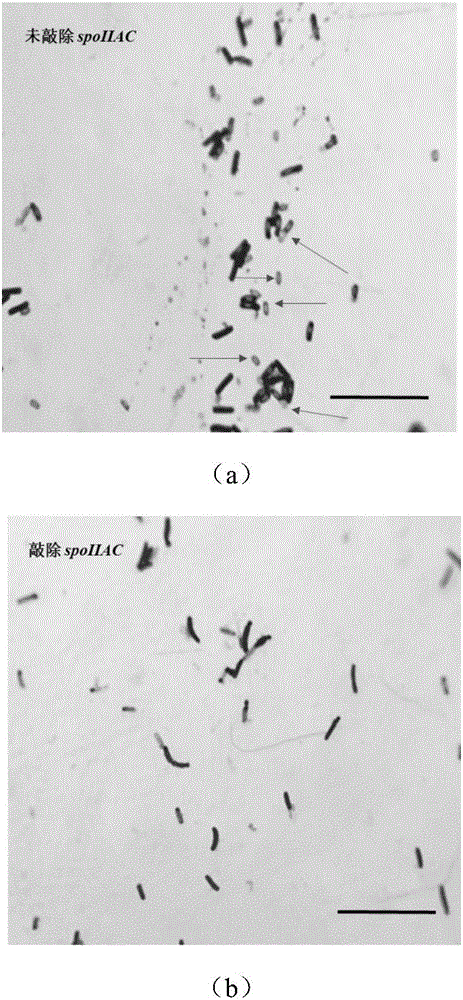Bacillus subtilis for efficient exogenous protein expression and high density culture
A technology of Bacillus subtilis and culture, applied in the field of bioengineering, can solve problems such as stop codons in the coding region, movement of gene reading frame code groups, etc.
- Summary
- Abstract
- Description
- Claims
- Application Information
AI Technical Summary
Problems solved by technology
Method used
Image
Examples
Embodiment 1
[0019] Example 1: Screening strains with high protein expression from collected soil samples
[0020] Take soil collected from different locations in different regions (garbage dumps, starch factories, vegetable markets, food factories, grain processing factories, hotels, etc.), mix 2g of soil samples with 9ml of sterile water, add glass beads and shake well Stand still for a while, take 5ml of supernatant and add it to LB medium, 25°C-37°C, 200r / min shaking culture for 2d-3d; 2. Take 10ml of culture solution and add it to another fresh LB medium to continue shaking culture, After repeating this operation twice, it was coated on LB solid flat plate. Inverted culture at 25°C-37°C for 2-3 days, a single colony can be observed and strains with good growth conditions can be screened; 3. Select and inoculate a single colony into a shallow well plate containing LB seed medium through high-throughput, 37°C , 200r / min shaking culture overnight. Then, according to the inoculum amount...
Embodiment 2
[0024] Embodiment 2: Construction of knockout plasmid
[0025]According to the gene sequence of Bacillus subtilis, the sgRNA used to specifically target the srfA, spoIIAC, amyE, nprE, aprE and bamA genes was designed, and the gene sequence of the temperature-sensitive replication origin of PE194 was found from NCBI (NCBIGenBank: M17811.1), Then chemically synthesized sgRNA and PE194 sequence (Genbank accession number JN798465.1: 7790-9126), using primers P1 and P2, PCR to obtain the vector backbone Frag1; using the shuttle plasmid pHY300PLK (Takara, Dalian, China) as a template, using primers P3 and P4, ampicillin screening gene and Escherichia coli replication origin p15A (Genbank accession number D90381.1: 5993-6537) were obtained by PCR, as the vector backbone Frag2; the shuttle plasmid pHY300PLK was used as a template, primers P5 and P6 were used, and tetracycline screening gene was obtained by PCR (Genbank accession number FN806789.3: 27499-28875), as the vector backbone ...
Embodiment 3
[0031] Embodiment 3: Bacillus subtilis transformation method
[0032] Dip frozen Bacillus subtilis WS with an inoculation loop, then streak on LB plates, and culture overnight at 37°C for activation. Pick a single colony and inoculate it in 5ml LB liquid medium, culture overnight at 37°C for 18h. Take a certain amount of overnight culture into 4.5ml of GMI, so that the OD600 value reaches 0.1-0.2, leaving 4.5ml of mixed bacterial solution. Shake culture at 200 rpm at 37°C, measure OD600 every 20 minutes, when OD600 reaches 0.4-0.6 (about 60-90 minutes); continue shaking culture for 90 minutes, draw 0.05ml of bacterial liquid into a sterile test tube containing 0.45ml of preheated GMⅡ medium; shaking at 37°C for 90 minutes, at this time, many competent cells formed in the culture; add 1 μg of plasmid (15-20 μl), shake and culture at 37°C for 30 minutes; centrifuge to remove most of the supernatant, resuspend the cells, and spread on Incubate overnight at 37°C on a screening p...
PUM
 Login to View More
Login to View More Abstract
Description
Claims
Application Information
 Login to View More
Login to View More - R&D
- Intellectual Property
- Life Sciences
- Materials
- Tech Scout
- Unparalleled Data Quality
- Higher Quality Content
- 60% Fewer Hallucinations
Browse by: Latest US Patents, China's latest patents, Technical Efficacy Thesaurus, Application Domain, Technology Topic, Popular Technical Reports.
© 2025 PatSnap. All rights reserved.Legal|Privacy policy|Modern Slavery Act Transparency Statement|Sitemap|About US| Contact US: help@patsnap.com



